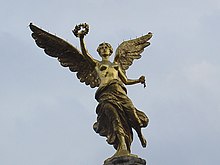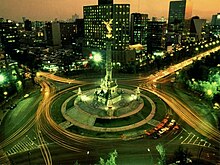El Ángel de la Independencia
El Ángel de la Independencia , or the Monumento a la Independencia , is a monument in Mexico City that is located on a roundabout at Paseo de la Reforma in the city center and is similar in shape and design to the Berlin Victory Column .
description
The bottom of the column is square, with a bronze sculpture on each side symbolizing law, war, justice and peace. Originally there were nine steps leading to the bottom, but as a result of subsidence , steps were added, making it 14 steps today.
On the front part of the underside, which looks towards the center of Mexico City, there is an inscription with la Nación a los Héroes de la Independencia ("the nation for the heroes of independence"). In front of this inscription is the bronze statue of a giant lion led by a child, representing strength during war and love during peace.
Near the pillar is a group of marble statues of some of the heroes of the War of Independence . The column itself is 36 meters high. The supporting structure is made of steel covered with stone, which in turn is decorated with garlands, palm trees and rings with the names of the independence images. Inside the column is a staircase with 200 steps that leads to a viewing platform above the capital. The capital, designed according to the Corinthian order , is adorned by four eagles with extended wings, the Mexican coat of arms of that time.
At the top of the column there is a sculpture that gives the monument its name. The 6.70 meter high statue, made by Enrique Alciati , depicts the winged goddess of victory Victoria . It is made of gilded bronze and weighs seven tons. In her right hand she holds a laurel crown , which symbolizes victory, while in her left hand she holds a broken chain, which symbolizes freedom.
history
The establishment of Ángel de la Independencia was ordered in 1902 by President Porfirio Díaz . The architect Antonio Rivas Mercado was responsible for the design of the monument, the construction work was supervised by the Mexican engineers Gonzalo Garita and Manuel Gorozpe. All sculptures were designed by the Italian artist Enrique Alciati . The memorial was planned to mark the centenary of Mexican independence in 1910. The opening ceremony was chaired by President Díaz and several other dignitaries. In 1925 the remains of the heroes from the times of the Mexican War of Independence were transferred to a mausoleum under the monument. The following were buried there:
- Miguel Hidalgo y Costilla
- Ignacio Allende y Unzaga
- Juan Ignacio Aldama
- José Mariano Jiménez
- José María Morelos y Pavón
- Mariano Matamoros
- Nicolás Bravo
- Vicente Guerrero
- Guadalupe Victoria
- Leona Vicario
- Andrés Quintana Roo
- Francisco Javier Mina
- Pedro Moreno
Since 2010, her bones have been examined, identified and preserved in the Museo Nacional de Historia in Chapultepec Castle .
Others
An eternal flame (Lámpara Votiva) , with which these heroes are honored, was placed on the underside of the column in 1929 on behalf of President Emilio Portes Gil . The monument was damaged during an earthquake on July 28, 1957 when the sculpture of the angel fell to the ground and shattered to pieces. This process inspired the Mexican population to make numerous jokes about the "fallen angel". The sculptor José Fernández Urbina was responsible for the restoration, which lasted over a year. The memorial reopened on September 16, 1958. It survived the devastating earthquake of September 19, 1985 undamaged. El Ángel has long been the traditional gathering place for celebrations of Mexico City residents, especially soccer victories, and it has become a prime venue for political gatherings.
Coin image
The sculpture of the goddess of victory on the top of the column is the model for the obverse of the Libertad investment coin series from the Mexican mint Casa de Moneda de Mexico .
Web links
Coordinates: 19 ° 25 ′ 37 ″ N , 99 ° 10 ′ 3 ″ W.



